March 15, 2017
KLM Royal Dutch London to Amsterdam 345p – 600p Fokker 70 Economy Class
Air Baltic Amsterdam to Riga 655p – 1010p Bombardier CS300 Economy Class
Once I’d made the decision to ride the
Trans-Mongolian from Moscow to Beijing rather than the other way around, I needed to find a way to get myself from London to Moscow. Rail travel from London all the way to Moscow was more convoluted and expensive than I desired and so my plan was to fly from London and Helsinki and then catch the overnight train to Moscow from there.
It was during the process of examining my options between London and Helsinki that I began to take notice of how affordable airfares had become throughout Europe and how this subsequently presented me with an opportunity to fly aboard some new airlines and/or aircraft along the way.
This is going to be a long trip report, so I’m not going to walk you through the convoluted process I went through to arrive at my ultimate travel plans. Let’s just cut to the chase.
While I had plans to visit with a friend who lives about an hour outside of London, I also had time enough to take a quick side trip from London to most any European city and back. The purpose of this side trip was not tourism related. It was strictly about flying out and back aboard what for me would be hitherto unflown airlines and aircraft. Those of you who may find yourselves snorting in contempt at this logic should remember that I am a huge fan of airlines and airliners – what in the modern vernacular would be referred to as an “Av-Geek”. I didn’t get to fly 192 different airlines by behaving normally like everybody else. Besides, my real destinations on this trip are the Trans-Mongolian Railway and Fiji.
I hadn’t researched the issue long before I came across a great opportunity to fly on a couple of new airlines while at the same time flying aboard a couple of jets that I’d never before flown upon – the older Fokker 70 and the brand new Bombardier CS300. KLM was offering a one way fare between London and Riga, Latvia for just $156.00 USD. KLM’s Fokker 70 would do the honors between London and Amsterdam, connecting to Air Baltic’s codeshare flight aboard the CS300.
Many people might look at a Fokker 70 and think they were looking at the more widely known F.28, which was introduced into service back in 1969 and has been operated widely throughout Europe, Africa and even the United States. The -70, which first flew in 1993, incorporates a number of improvements which aren’t readily noticeable to the untrained eye. Most notably, the Fokker 70 and it’s larger brother the Fokker 100, have more modern avionics, a pair of new-generation Rolls-Royce Tay turbofan engines and a redesigned wing that is said to be 30 per cent more efficient at cruise speeds. For all that however, the Fokker 70 – with a passenger capacity of about 80 depending upon seat pitch – never attracted many customers. Only 48 of them were built before Fokker went bankrupt in 1996.
Not surprisingly, the world’s largest operator of the Fokker 70 is Holland’s KLM CityHopper with a current fleet numbering thirteen. Although Fokker’s F100 sold well in North America (American, Midway, US Airways, Intair, Jetsgo, Aviacsa, Mexicana), the F70 didn’t with only two having been delivered to Mesa Airways who operated them briefly on behalf of America West Express before deeming them unprofitable for its operation and sending them back to Europe.
In any event, I missed my chance to fly upon the Fokker 70 during its brief time with America West Express and had pretty much written off my chances of flying on it what with KLM phasing out its final Fokker 70 at the end of October this year. KLM began flying F70s in 1996 but its fleet is now 20 years old, with each aircraft having performed around 38,000 flight hours. KLM is already beginning to replace its -70s with comparatively pedestrian (but cost-efficient!) Embraer E175s and E190s.
So then, you can imagine my surprise and delight when I saw a chance to log a flight aboard the hitherto elusive F70 along with the brand new CS300 for what I deemed to be a very affordable price.
Fast forward to London’s Heathrow Airport where I needed to get myself from BA’s Terminal 5 over to Terminal 4 from whence KLM now operates. I had about two hours to do so. Complicating matters was the fact that I’d decided to store my roll-a-bord at Heathrow rather than risk having it misplaced during the 55 minute connection at Amsterdam or having to pay for it while flying LOT back to London. In every regard, it was cheaper to pay the £18.50 baggage fee at LHR.
Moving along, by the time I’d located left luggage, checked in, cleared security and walked the quarter mile down to the gate, there was no time to enjoy either of the two lounges I had available to me through Priority Pass. I did however manage to get off a decent shot of my attractive two-tone blue and white Fokker 70 waiting at the gate.
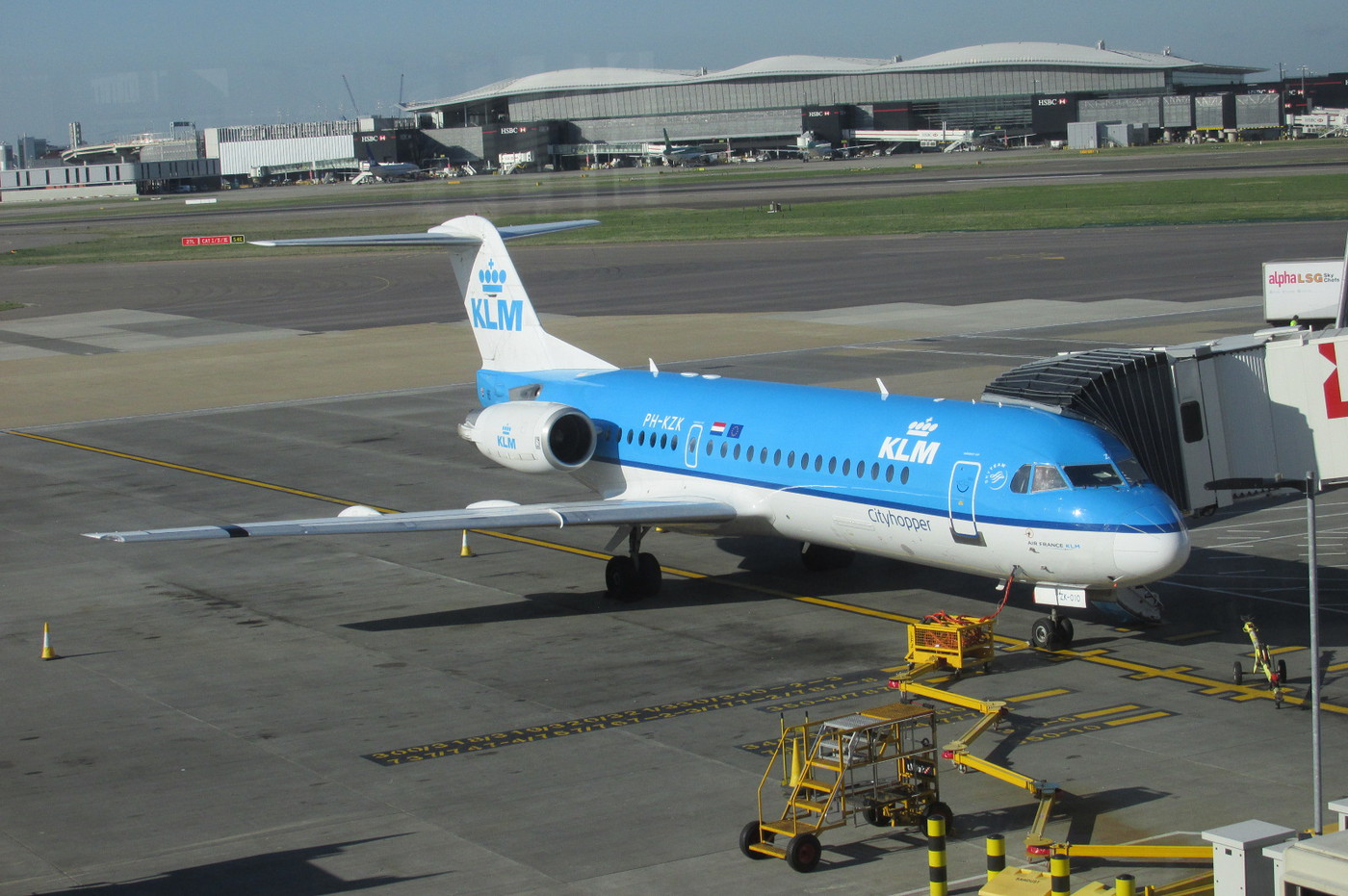 KLM’s Fokker 70 Awaits
KLM’s Fokker 70 Awaits
This being a new plane for me, you’d think I’d be Johnny-On-The-Spot and be first in line to board. Nope. That was reserved for Business Class and SkyTeam Elite passengers. By the time boarding was announced for the rest of us heathen, a sizeable line had already developed and by the time I took my spot at its rear I was amongst the last to board. Forty years ago I probably would have been amongst those early boarders but these days, some 5,150 some odd flights later, I just can’t be bothered. It’s not that I’m not excited to get on and check this airplane out but these days it’s just not in my make-up to be so anxious and hurried.
That said, when I do finally make my way down the jetway for that first flight, there’s always a bit of excitement and anticipation as I’m looking forward to seeing what this plane looks like inside – not just the physical cabin but the furnishings as well. What’s Business Class look like? What color is the carpet? What color are the seats? I know, I know what you’re thinking. Still, I am unrepentant. This is exciting stuff!
Sadly, in the post-deregulation era that we’ve all lived in for some time now, homogeneity is all the rage. Once you’ve been in one narrow bodied jet you’ve pretty much been in them all. 737s, A320s, Fokkers, Embraers – there may be some minor differences in the physical cabin but in terms of seating and ambience they’re all pretty much the same – dark blue or grey seats with plain white sidewalls . Anybody remember when BOAC had checkerboard patterned fabric covering some of its economy class seats or when TWA’s sidewalls had hot air balloons and European scenes. Continental must have employed twenty different colored and patterned fabrics in the back of its DC-10s while United – always more conservative – employed at least three different solid colored fabrics aboard its DC-8s and 727s. First Class seats were always solid red while behind the curtain you’d see a mix of white, beige or turquoise.
By today’s more conservative standards, KLM’s little F70 looked quite fetching with 78 dark blue patterned seats arranged in a 2-3 configuration. A small curtain divided Business Class from the rest of the aircraft but other than that there was little to differentiate the product, for which you pay a whopping $290.00 USD more on the 230 mile LHR-AMS run. All seats were exactly the same throughout the aircraft with possibly a couple inches more inches more leg room up front. Other than that, Business Class clientele are offered a slightly nicer meal and free booze.
As things turned out I wasn’t quite the last passenger to board, but once the last of the stragglers had taken their seats the crew buttoned us up, dispensed with the pre-flight safety announcements and sat down for take-off. The captain throttled up his twin Rolls-Royce Tays, released the brakes and off we went – thundering down the runway until taking to the air just 22 seconds later.
Seated up in 7A, I must say the F70 is a relatively quiet airplane inside. No doubt those sat closer to the hum of those Rolls-Royce Tays might have a different opinion but overall I was impressed. Equally impressive was the beautiful English countryside, downright verdant after what must have been a warm and possibly rainy winter. It looked like summer down there.
A 230 mile flight doesn’t allow much time for service – indeed, some airlines wouldn’t even bother – but KLM’s crew rolled out the trolley and passed out tasty falafel and vegetable wraps to all who so desired. The wraps were housed in a blue delft patterned box and came with a container of water.
Flight time was just 41 minutes, so it wasn’t long before we were making our descent over the North Sea while on our way into Amsterdam’s Schiphol Airport. We parked remotely amidst a flock of other CityHopper jets, including one of the new Embraer E-190s. The bus took us on quite a circuitous ride around the airport, finally depositing us in the bowels of the D concourse, which appeared to be KLM’s main base of operations.
This was my first time flying through Schiphol and I was curious to get a feel for the place. Always considered a people-friendly airport dating from its reconstruction back in the 1970s, I think it still is. Its corridors are generally spacious and well-lit while its commons areas offer an attractive variety of shops and restaurants. Too bad I only have 55 minutes here. Less really, given that I’ve got to hustle from the D across to the B concourse and then down its entire length to gate B-14 where my CS-300 awaited.
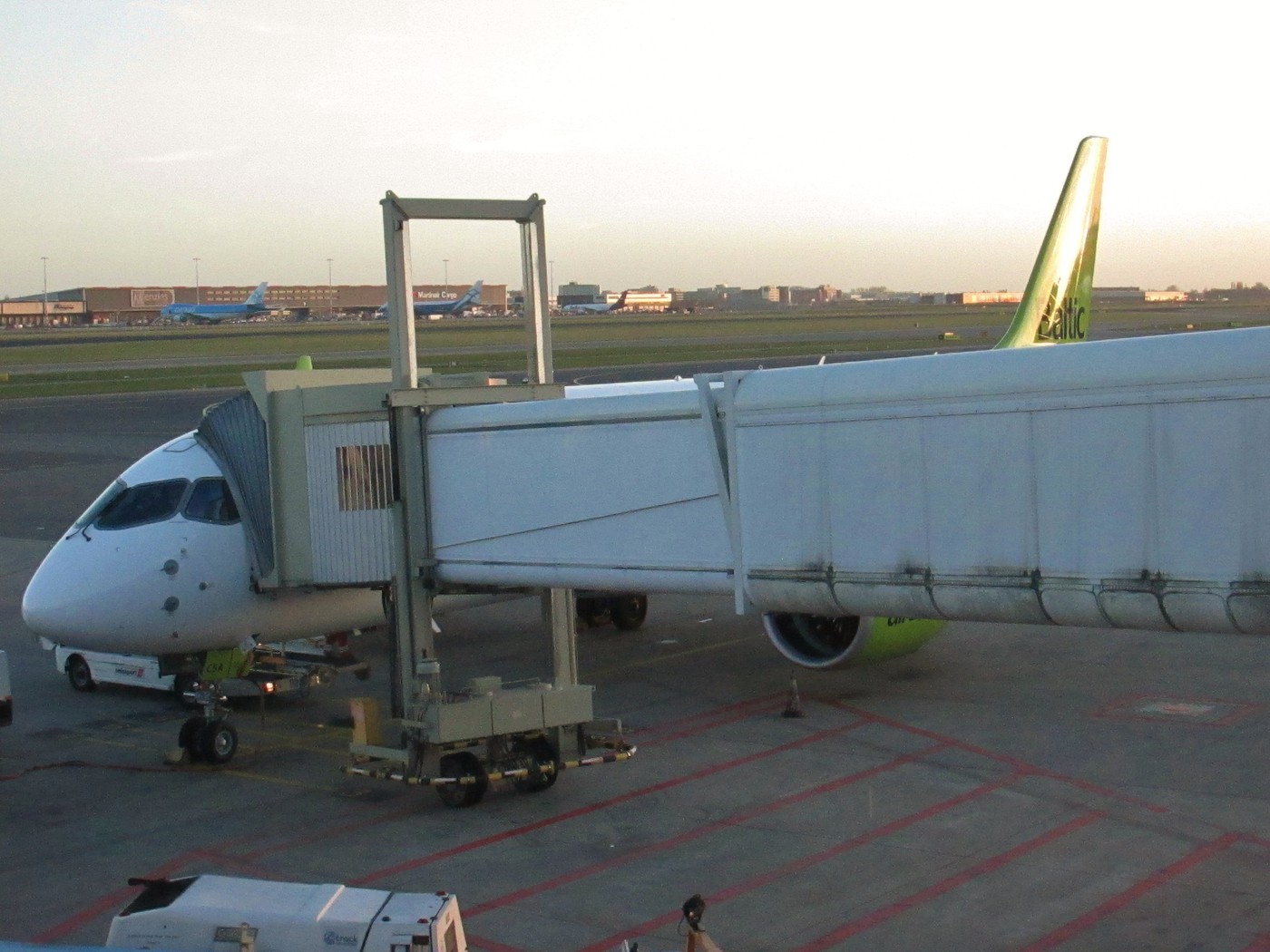 Air Baltic’s new CS300 awaiting departure to Riga
Air Baltic’s new CS300 awaiting departure to Riga
It is always exciting to fly upon a new aircraft - especially so for me, even after 5,272 flights. My mom played a big role in my early interest. She loved to travel but unlike most women, she also took a real interest in the mechanisms of travel. Be it a train or a plane, she was well aware of what she was traveling upon and she always looked forward to getting there as well as being there. Suffice to say, her enthusiasm was infectious. To me at least. I have three sisters who could care less about “getting there”. My dad, by the way, was an early member of United’s Million Miler Club but aside from sending me neat postcards of airliners he’d flown upon, his personal interest in flying was otherwise minimal.
It should be noted that the early and mid-1960s were a very exciting time for aviation enthusiasts. Jets had only been flying around America for less than ten years and, with the introduction of the 727, DC-9, BAC-111 and Caravelle, many small and medium sized airports were seeing jet service for the first time ever. Jets were exciting and on the whole, so was a significant percentage of the American public. Many airports had viewing decks and it was not at all uncommon for people to drive out to their local airport to experience the sights and sounds of these new jetliners, even if they weren’t personally flying anywhere.
As a kid, I remember afternoon trips out to Denver’s Stapleton International Airport where a parking area was located alongside the east-west runway. The predominant jets of the early 1960s were 707s and DC-8s, big four engine jetliners that made a lot of noise and left big trails of smoky exhaust during takeoff and climb out. It was always a thrill to hear one of United’s noisy DC-8s take off or watch as a smoky Convair 880 approached from afar. Wow! Here comes a red Braniff 707! Afterwards, we would often visit the airport restaurant where I remember remarkably tasty club sandwiches and excellent views of the tarmac.
Today, lo many years later, that excitement is still there if a bit muted from my earliest days. I’ve been reading about the development and production of Bombardier’s C series for a few years now. After a number of starts and stops in the development phase, sales and production began in earnest in 2008. The sales pitch highlighted that the new Pratt & Whitney geared turbofan engines should provide 12 percent better fuel economy than existing engines while also being quieter. Further improvements to the airplane’s aerodynamics and the use of lightweight composite materials should also contribute up to 15% better operating costs than similarly sized jets.
In terms of production, the C-series jets employ technology and manufacturing expertise from all over the world. The wings are developed and manufactured in Belfast, Ireland while much of the fuselage is built in China. The aft fuselage and cockpit are manufactured in Saint-Laurent, Quebec and the final assembly of the aircraft is done at Bombardier’s plant at Mirabel Airport outside Montreal. Many other companies from around Europe and America also contribute to this aircraft’s design.
Two C-Series models are currently flying. Swiss Air Lines launched the CS100 back in July of 2016, while Air Baltic launched the larger CS300 just three months ago in December of 2016. Other airlines that have ordered the CS series include Air Canada, Delta, Gulf Air and Lufthansa. Delta gave the program a huge boost when it ordered 75 CS100s.
When boarding was called, I was amongst the first 30 or so to board, a considerable improvement from my usual laggardly style. I’d requested seat 7A, a window seat on the two-seat side of the aircraft. The first thing I noticed upon entering the cabin was its width. Air Baltic’s CS300 is configured to seat 145 configured 2-3. Aside from the 2-3 layout in Business Class, the cabin looked clean and uncluttered with all seats being upholstered in pleasing cream colored leather. A green tint emanated from atop the sidewalls next to each row. Seat pitch was fairly generous at about 31” and the seat – definitely not a slimline model – felt pretty comfortable as well. I immediately liked the larger windows – on par with those found on Embraer’s family of jets. The overhead storage bins were also surprisingly spacious for a regional aircraft. I had no problem stowing my 21” roll-a-bord wheels in first.
My seatmate, Dmitri, was a Latvian national who spoke flawless English thanks to three years as an exchange student in California some years ago. Married with two children, his job had him flying regularly between Riga and London. He too was quite pleased with Air Baltic’s new jet, especially after flying aboard the airline’s ‘crappy old” 737-500s, which he described as being rundown and long overdue for retirement.
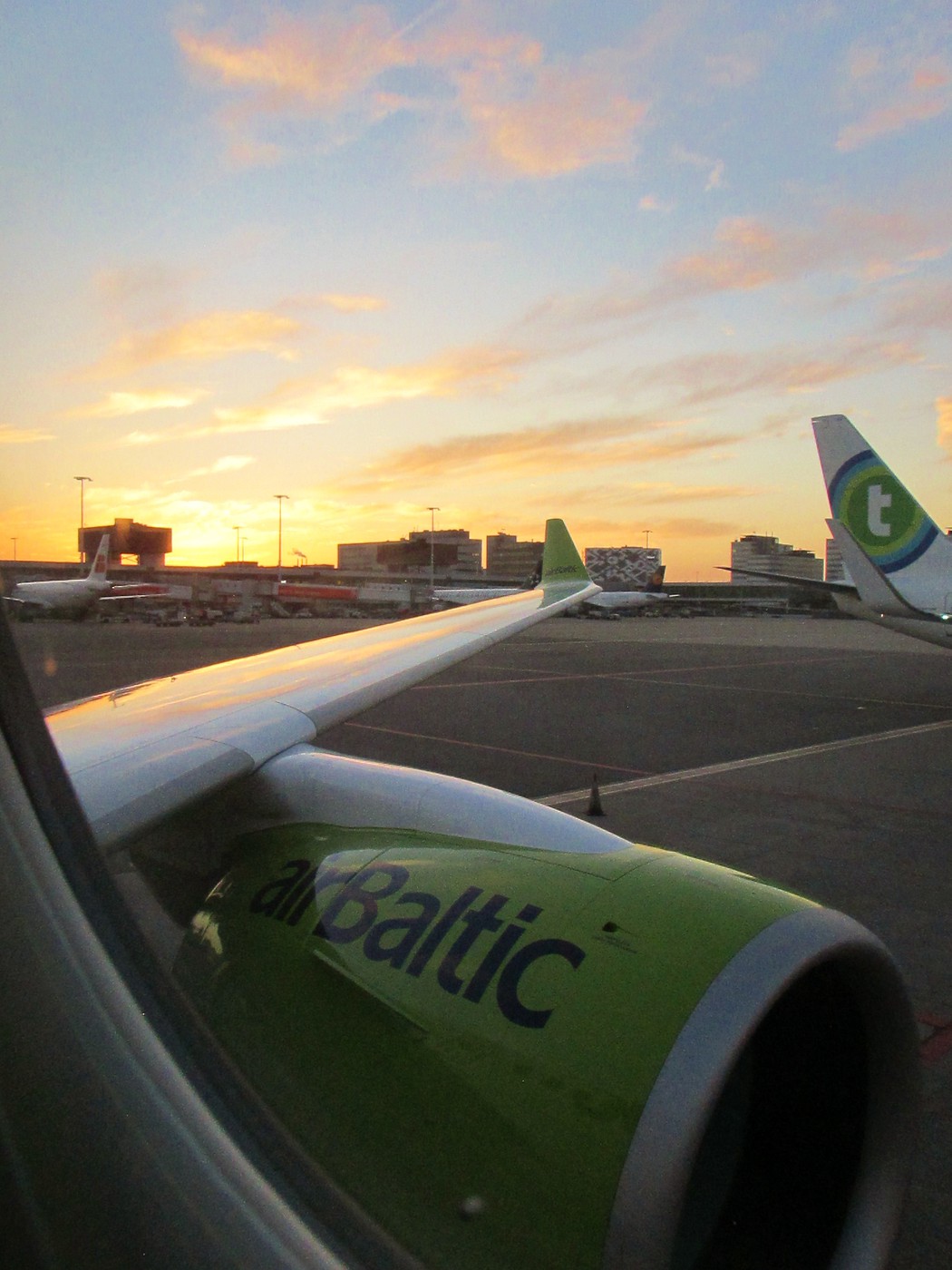 Sunset on the Amsterdam ramp
Sunset on the Amsterdam ramp
 Air Baltic’s new CS300 cabin ambiance
Air Baltic’s new CS300 cabin ambiance
Takeoff was typically swift and exciting as we leapt into the heavens with what felt like an impressive angle of climb-out. Flight time on this 830 mile flight to Riga was projected to be about two hours and ten minutes, plenty of time for the crew to provide a leisurely service – which they did, though perhaps a bit too leisurely by my experience. Service commenced about 30 minutes into the flight with the meal and beverage cart. There was only one pass, so unless you wanted to go back and bother the flight attendants in the galley as I did, you needed to place your order on the one and only go round.
Air Baltic offers a decent inflight menu that includes full hot meals which can be ordered and purchased in advance of the flight. Nothing is complimentary, however. Water, coffee, sodas – all came at a cost. I shelled out €2.00 for a coffee and later, another €2.50 for a bottle of water. During that trip back to the galley, I also paid a visit to the lav, far and away the largest I have ever seen on a single aisle aircraft, approximate in size to the First Class lavs on Cathay Pacific’s old 747-400s.
Time flew by as Dmitri and I enjoyed chatting throughout the flight. Touchdown at Riga International was nicely executed and we taxied briskly up to our gate, parking next to one of the aforementioned “crappy old” 737-500s. Funny thing is, you’d never know it from the outside. The airplane looked as clean and shiny as if it had been delivered by Boeing last month, not 25 years earlier as a check of its registration revealed.
My home for the night was the Rixwell Elefant Hotel. The name comes from the fact that there’s an elephant in the lobby. Well, kind of one. It’s made of bronze or something that looks bronze and is about 4 feet high at the shoulder. As for my room however, it was every bit as nice as the pictures on the website from which I’d purchased it. How often does
that happen?!
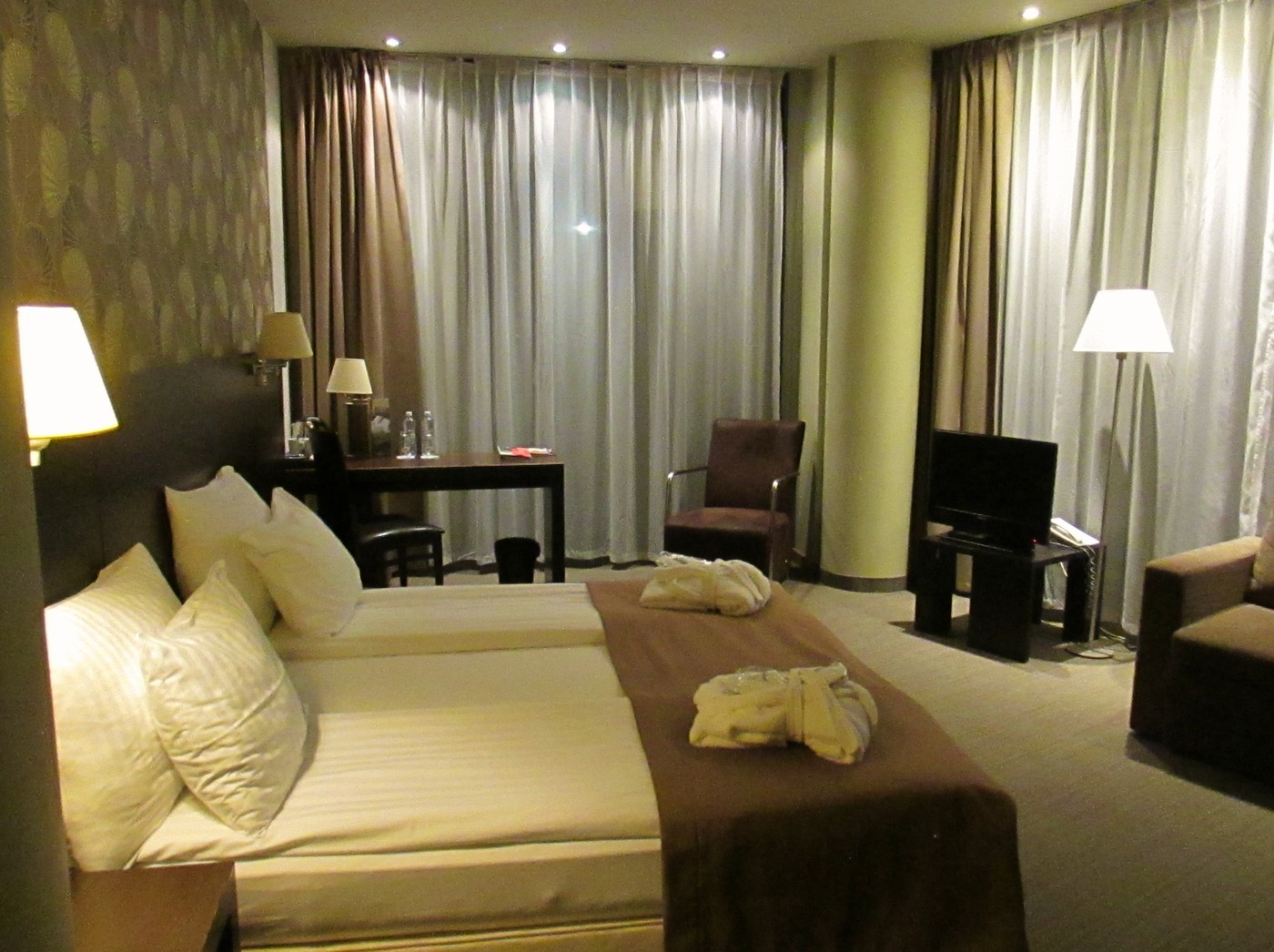 Deluxe King Room at the Rixwell Elefant Hotel in Riga, Latvia
Deluxe King Room at the Rixwell Elefant Hotel in Riga, Latvia
My room rate of €53.20 included an exceptional full breakfast buffet, of which I took full advantage prior to catching a taxi back to the airport.
I didn’t get to see much of Riga, but what I did see and experience makes me want to come back here again for a longer stay.
March 16, 2017
LOT Polish Riga to Warsaw 150p – 205p Embraer ERJ-175 Economy Class
LOT Polish Warsaw to London 330p – 520p Boeing 737-400 Economy Class
Once upon a time, flying upon eastern European airlines like LOT was considered to be quite an adventure – and I don’t mean the good kind. We used to joke that LOT stood for Look Out Tower! Over the years however, most all of the old communist bloc country airlines have divested themselves of their aging Soviet era jets and transitioned to newer, more reliable western models from Boeing, Airbus and Embraer.
A search on Skyscanner revealed a plethora of possibilities for air travel between Riga and London. Connections through countries like Hungary, Czech Republic and even Turkey were available at decent prices. I briefly considered routing through Prague on a pair of second tier Czech airlines but ultimately didn’t like the connection time and so decided to go with LOT through Warsaw. Total cost: $115.00 USD.
Riga’s airport is not very large, but once you get past security it opens into a bright, spacious concourse with plenty of shops, eateries and my favorite – lots of natural light. At the entrance to the concourse is the Primeclass Business Lounge, which so far as I know is the only Business Lounge available at RIX.
The receptionist ran my Priority Pass card and then provided a brief tour of the facility. She had time to do this since there was only one other person in the lounge. I found a nice collection of seats over by the windows and then headed over to have a look at the food and beverage area. I wasn’t all that hungry, having just had breakfast two hours earlier, but I can always make room for coffee and a biscuit. Had I so desired, a broad range of foods ranging from pastries to sandwiches all the way up to hot beef stroganoff and rice was also available. A tall glass door refrigerator offered a decent selection of juices, sodas, beers and water.
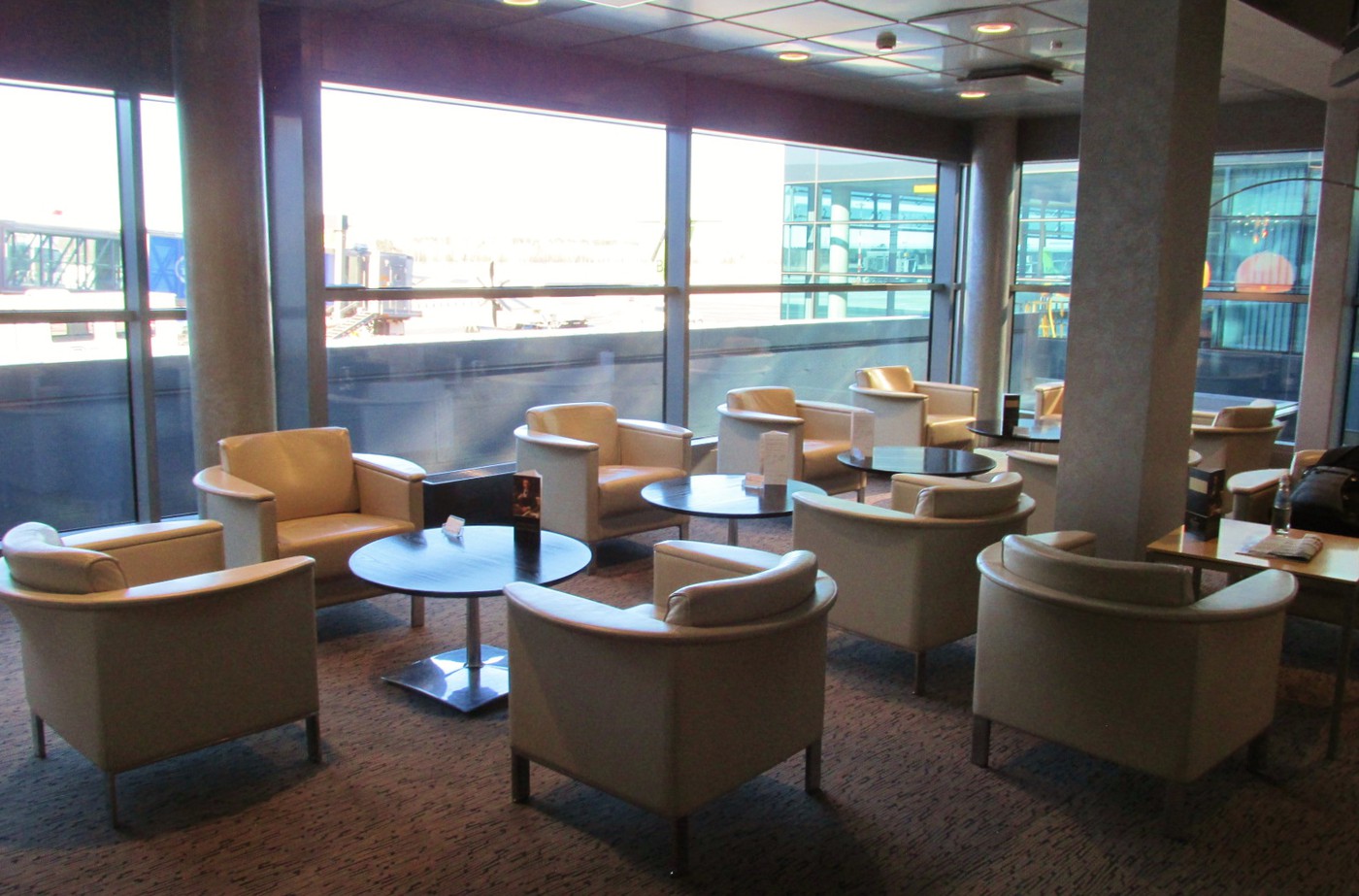 Primeclass Business Lounge
Primeclass Business Lounge
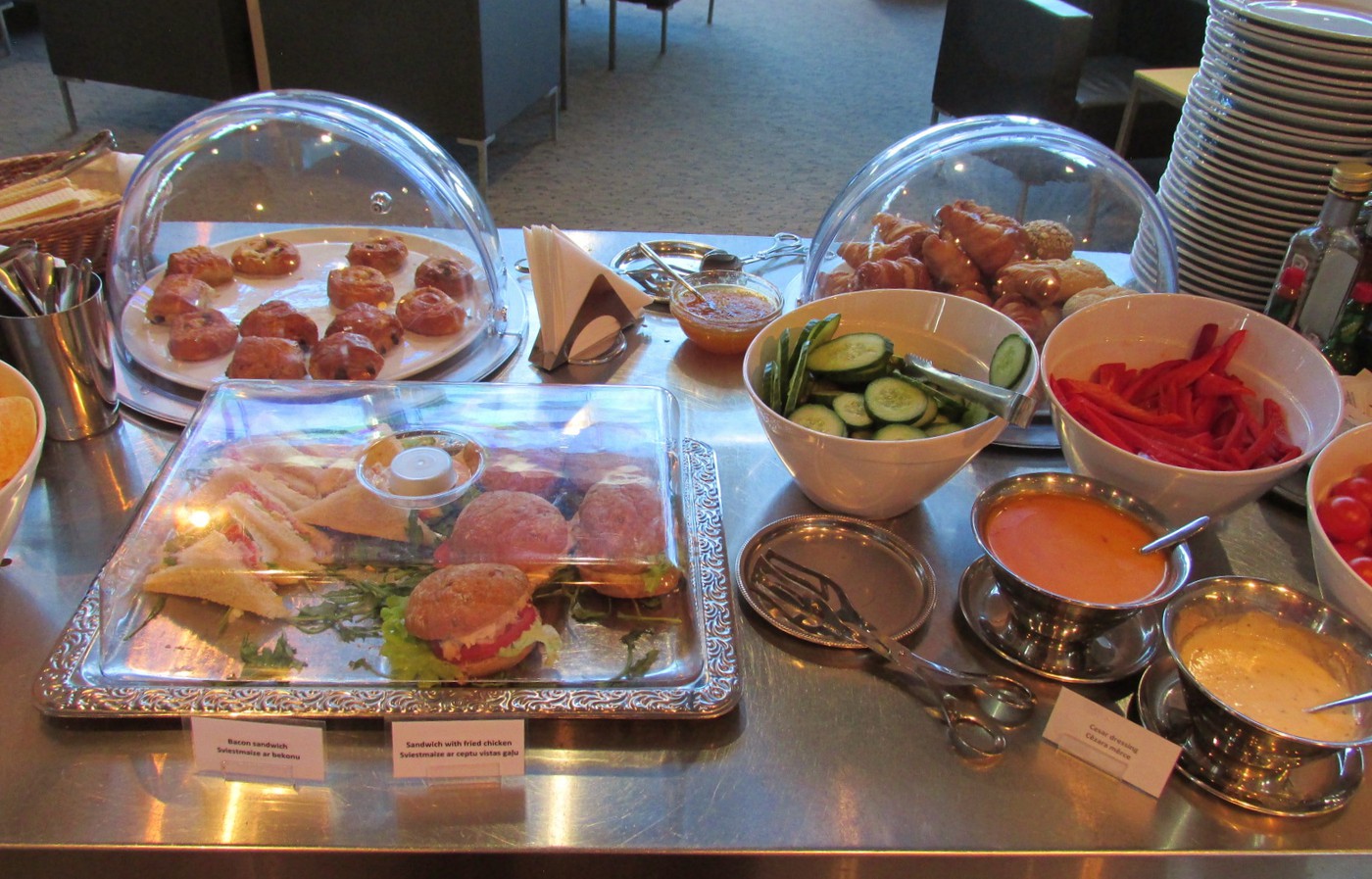 Primeclass Business Lounge Offerings
Primeclass Business Lounge Offerings
It was about 1:15pm when I made my way up to gate 5. Along the way I stopped at a duty free shop to check out their plug adaptors as it seems my adaptor kit was somehow missing its European plug. Oh my God! The prices were extortionate! €28.50 for a simple plug adaptor? No thanks! I’ll have a look in Warsaw. Besides, I won’t really need one again until I arrive in Helsinki in a couple of days.
LOT’s sharp looking little ERJ-170 was just taxiing up to the gate as I arrived. It was a nice day, so I paused to take a picture.
 LOT’S ERJ-170 at the gate in Riga
LOT’S ERJ-170 at the gate in Riga
One could argue that if you’ve been on one regional jet, you’ve pretty much been on them all. To be sure, that argument generally works – except amongst those of us with an eye for detail. The first thing I noticed was the three rows of Business Class seats with signs on the headrests reading “
This seat has been blocked for your comfort”. Other than that they appeared to be the same as those in economy, including seat pitch.
Moving on to my economy seat in row 11, I sat down and was immediately impressed. Decent legroom, comfortable padding – I like it. The guy across from me had somehow managed to get a large bag past the gate agents but the ERJ-170 was having none of it. It wasn’t long before a flight attendant showed up to have the bag checked.
Flight time to Warsaw was just 50 minutes – time enough for a quick pass with the beverage cart and little else. Well, there was something else – a Kit-Kat style candy bar doled out by the flight attendants. I threw it in my daypack for later.
It was cool and overcast when we landed at Warsaw’s Frederick Chopin International Airport. Lined up on one concourse were five LOT 787s. The fleet’s all in! Almost. LOT currently operates six Dreamliners. We parked remotely amidst three or four other regional jets, then bussed into the terminal.
A check of my lounge options prior to departure revealed two Priority Pass affiliated lounges available to me here. As I made my way through the airport I took notice of the LOT Business Lounge. Hmm… usually the best lounge in any airport is that operated by the hometown airline. As a lifetime member of the United Club - and travelling aboard a fellow Star Alliance carrier today – I wondered if my club card would grant me access. It did!
LOT’s Business Lounge is surprisingly small for serving the airline’s hub. Turning my attention to the food island, I took note of a delicious smelling cabbage and sausage soup. Also available was a hot goulash looking dish and some good looking pastries. I still wasn’t all that hungry but after watching a guy ladle himself a bowl of that delicious smelling soup, I couldn’t resist. Mmmm! Yah mon! Good stuff!
 LOT’s Business Class Lounge at Warsaw
LOT’s Business Class Lounge at Warsaw
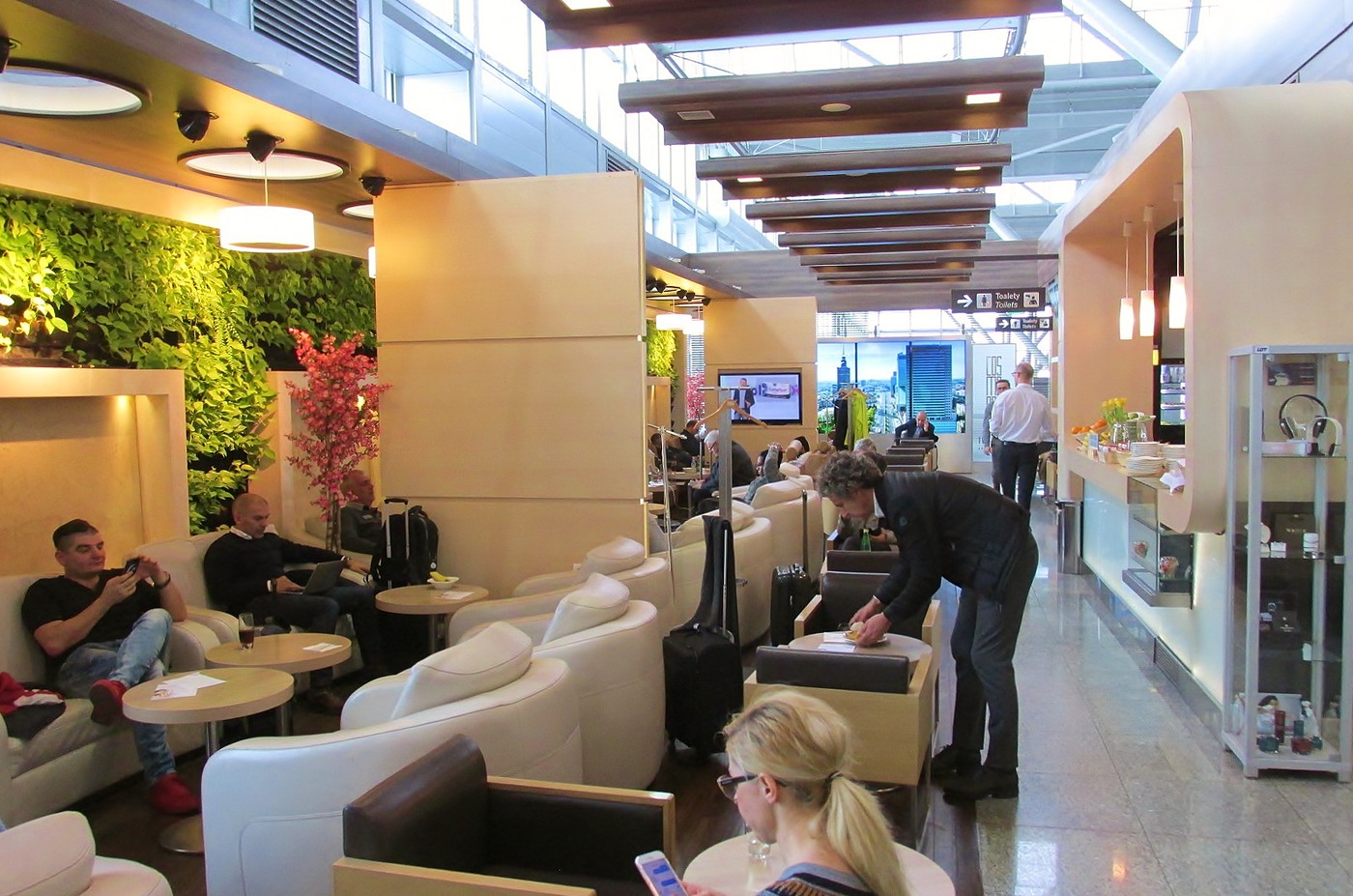 LOT’s Business Class Lounge at Warsaw
LOT’s Business Class Lounge at Warsaw
A check of the departures board revealed that those 787s were headed everywhere from New York and Chicago to Beijing and Bangkok. One flight that caught my eye was a TUI charter operating from Warsaw down to Montego Bay. What a wonderfully exotic routing – from a grey and dreary day in Warsaw to sunshine and Planters Punch on the beach in Montego later tonight. I wondered if TUI had a premium class product… No way am I doing that flight crammed into the standard European charter configuration.
Leaving the lounge, I headed down to the end of the concourse where I checked out a good looking Belavia 737-500 while awaiting the boarding call for my flight. When it came, I dutifully took my place at the end of the line and slooowly made my way down through the jetway. Dang! Whatever could be taking these people so long? I’ve stood in a lot of jetways in my time but this crowd moved like molasses in January. Maybe LOT should have its flight attendants double as barkers to encourage those arguing over seats or taking forever and a day to put stuff in the overhead to speed it up.
I’m reasonably patient to a fault but I’ve addressed the issue a couple of times while stuck behind some inattentive or uncaring passenger(s) who seem oblivious to the fact that this isn’t their private jet and/or seem to have no situational awareness. “Hey Knuckleheads! (You guys!), we got about 90 people waiting behind you here. You wanna finish it up there?” I know, I know… shocking and rude, but I’m more than up to the task when the situation warrants it.
When I finally did step aboard the 20 year old 737, I was at once impressed by the stylish two-tone blue interior which gave it the look of a much younger airplane. At the same time I was amazed at how thin those thin line seats were. I kid you not when I say that they were only a little more than an inch and a half thick at their top third.
The flight itself was fairly nondescript. The advertised snack turned out to be another Kit-Kat type bar with coffee or water though I vaguely recall that there was an inflight menu from which one could purchase the usual inflight goodies. Landing at Heathrow was a few minutes early and Bob’s Your Uncle!
* * * :-: * * * :-: * * *
Had I known then what I know now, I just might have risked checking my bag on to Riga rather than storing it at Terminal 4. Instead, upon deplaning at Terminal 2, my back and legs sore from two hours in those cheap slimline seats, I commenced to following a tortuous and convoluted path around and under what seemed like the entire airport. It began with a long walk out of the T2 gate area through customs and immigration, which thankfully was near deserted. I then continued on through a never ending series of walkways eventually leading me out to the Heathrow Express train, which provides free shuttle service over to T-4 and 5. Of course after the long walk just to get to the train, I then had to wait a further 18 minutes for it! Arriving at T4, I then made my way upstairs and all the way across the terminal to the baggage storage place, where I was then informed that I could get to the Central Bus Terminal by simply catching the Underground. It’s free, and the escalator leading to it was just outside and to the right. Roight! Off I go, though I should have known that getting to the Underground could never have been quite so easy as just riding down an escalator. No, there were more corridors to be walked, though thankfully not so many as at T2. Arriving at the Underground, I then find out that although it’s free, I’ll need to purchase something called an Oyster Card to ride it. “How much is that?” I ask. It’s a £5.00 minimum was the reply. Just to get to Terminal 2/3? No, that’s free. But you’ll have to buy the £5.00 Oyster Card to ride the Underground.
Sigh… You know though, I didn’t get to a point where I can afford to take trips like this by just casually chucking money around, even amounts as small as £5.00 (most of the time) and I wasn’t in the mood to do so now. So – I turned around and made my way back up the corridors, back up the escalator, back across Terminal 4 and down to the Heathrow Express where I discovered I’d have to wait another 13 minutes for the next train. Hhhhhh.. whatever…
Of course, it’s no short stroll from the Heathrow Express to the CBT, so off I set. At this point mere discomfort has morphed into outright pain that left me questioning whether I was quite ready to have undertaken a trip of this scope. Mentally, I’m always ready! Physically, ah… well, here I am so keep pounding! When I get to the bus terminal I’ll take something for the pain.
I didn’t have long to wait for the bus to Reading and two hours later I was enjoying burgers and brews with my friend at a nice little pub in Wokingham. What a day!
The next afternoon I caught the train from Wokingham out to Heathrow, then a taxi to the Ramada Inn where a small but comfortable room could be had for just £39.20. The room was necessary due to my early departure up to Helsinki the next morning.
March 18, 2017
Norwegian Airlines London to Helsinki 910a – 210p Boeing 737-800 Economy Class
I’ll bet if someone had told the average Londoner back in 1977 that they could one day fly 1,150 miles from London to Helsinki for the equivalent of just $74.00 USD one way, they’d have told you that you were dreaming. Well, dream on because in this day and age of deregulated airfares, those ridiculously cheap fares are a reality.
Of course, they often entail putting up with long lines, ridiculous baggage restrictions, uncomfortably tight seating and surly flight attendants. Not so when flying aboard up and coming Norwegian Airlines. The airline has won multiple awards for its fine, overall product including SkyTrax’s coveted Best Discount Airline in Europe and World’s Best Discount Airline.
Well, they certainly had the Discount Airline part covered, because to pay just $74.00 USD to fly 1,150 miles anywhere on the planet is one heckuva good deal. As for the airplane and the service – well, more on that in a moment. First, let’s check out the lounge scene here in Gatwick’s South Terminal.
As has been my experience with London’s two largest airports, getting from point A to point B is rarely as simple as it would seem. Notwithstanding, I actually made my way through security and on to the lounge without too much fuss. The lounge, named the No. 1 Lounge, provided a comfortable and well-staffed place to while away an hour and a half in advance of my flight. It was bright and welcoming, with a nice selection of foods and beverages on offer – not to mention killer views of the Gatwick tarmac and runway. I ordered something called a kedgeree, fixed myself up a cup of latte from the coffee machine and then put in a bit of time on this trip report. Overall, the No. 1 Lounge was as nice a lounge outside of the Concorde Room and Emirate’s T3 Lounge as I’ve ever visited in London.
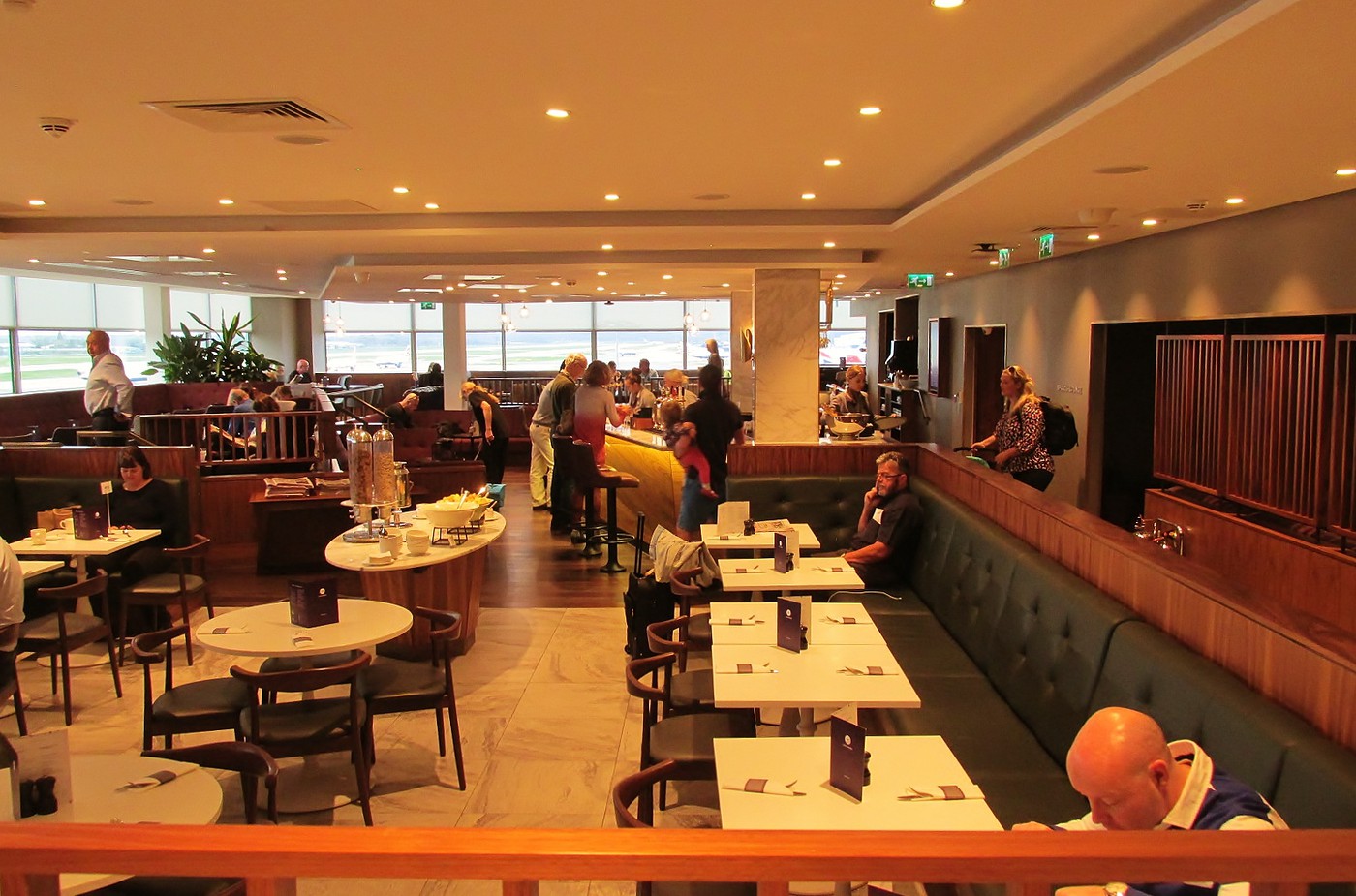 Premier No. 1 Lounge at Gatwick
Premier No. 1 Lounge at Gatwick
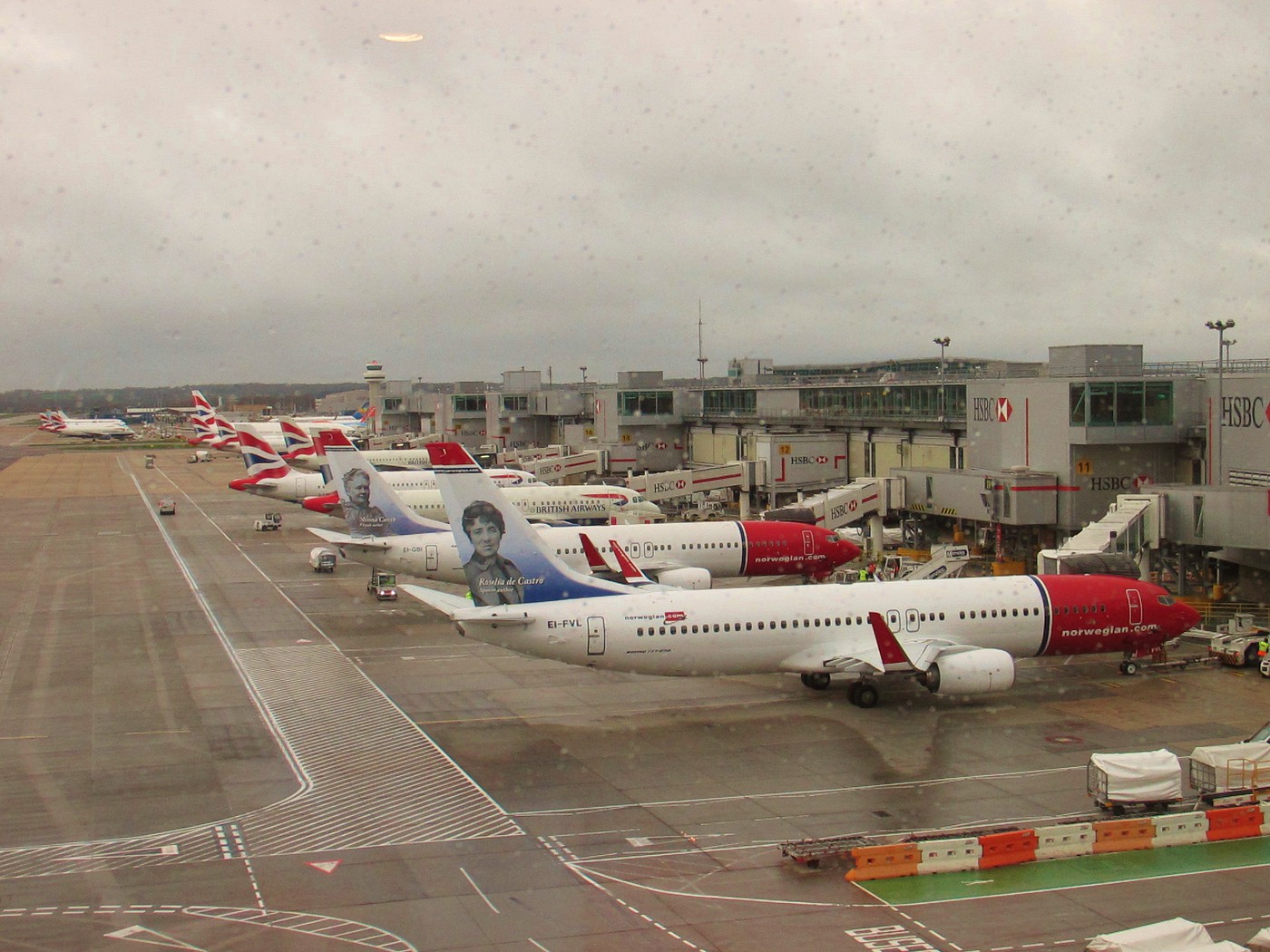 Tarmac view from the lounge
Tarmac view from the lounge
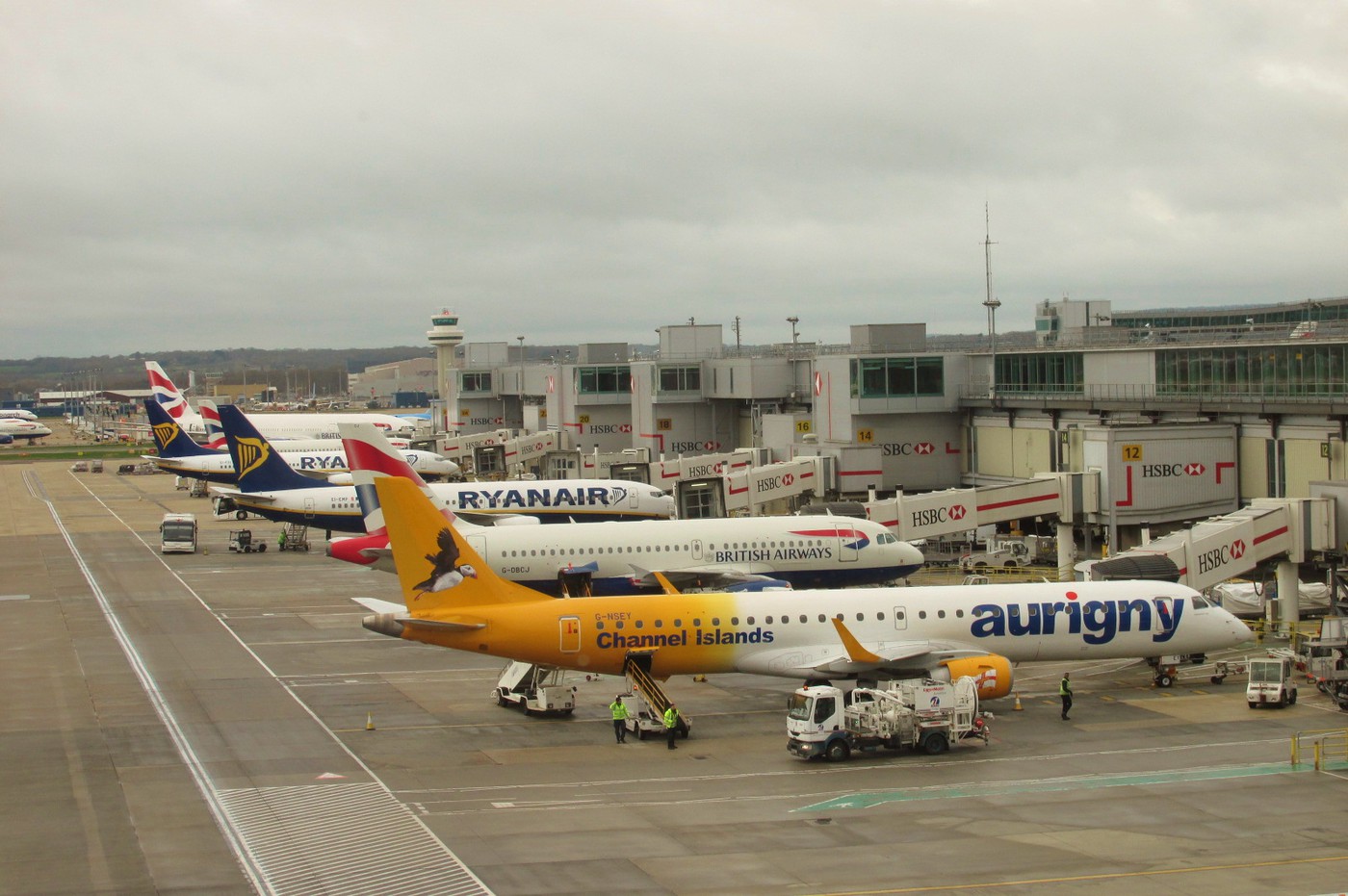 Tarmac view from the lounge
Tarmac view from the lounge
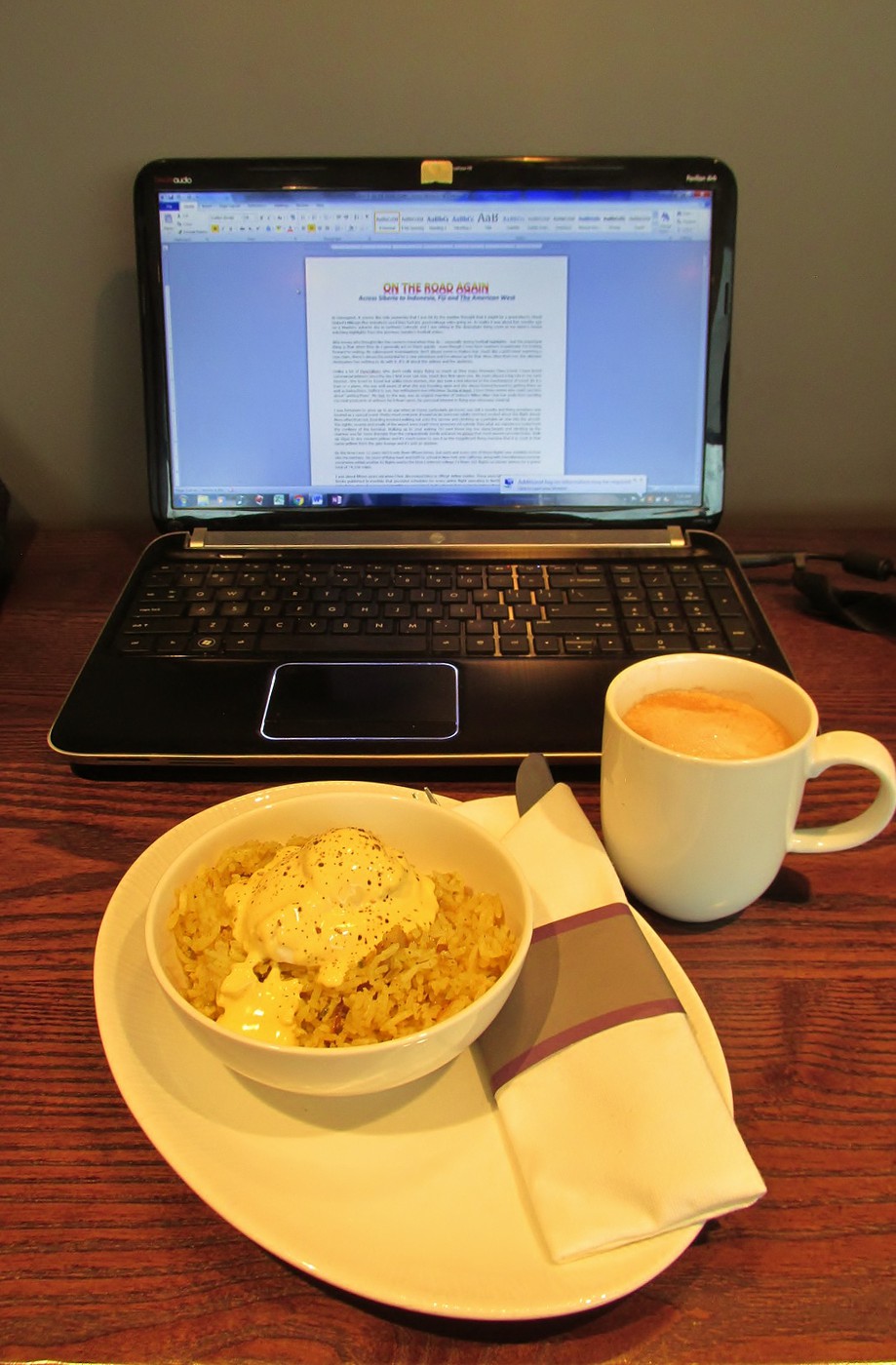 Kedgeree and Coffee
Kedgeree and Coffee
Getting from the lounge down to the airplane was a typically convoluted affair that I’ll spare describing for you all. Never having flown Norwegian, I was not only looking forward to the flight experience but also seeing which famous Norwegian would be emblazoned upon the 737-800’s tail. Alas, it seems we got the one aircraft in the fleet that had a plain white tail. This being my 5,276th flight and Norwegian being my 184th airline flown, it occurred to me that perhaps I could grace some airliner’s tail someday but, not being Norwegian, I guess it won’t be this one.
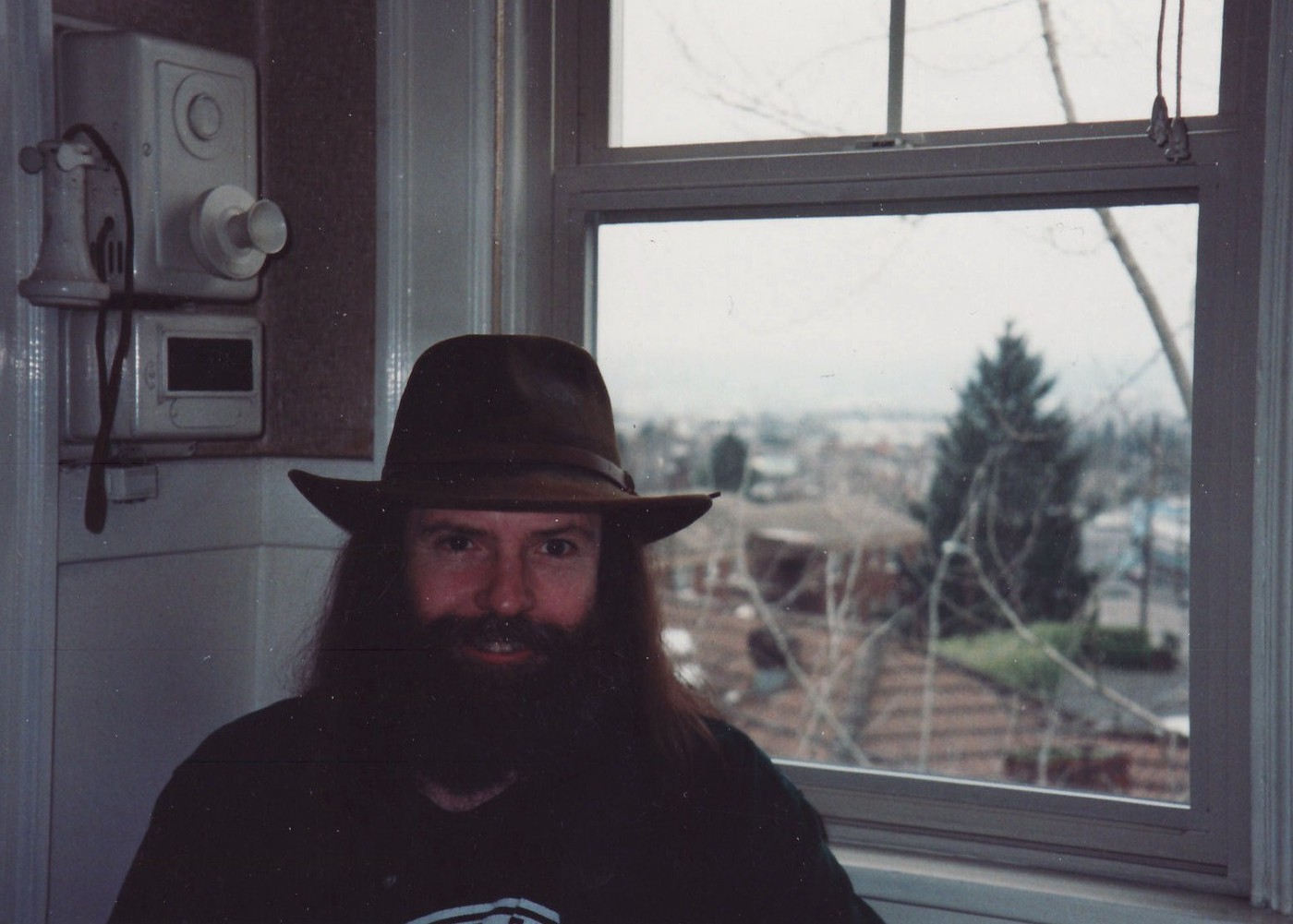 Would you put this guy on an airliner’s tail?
Yours truly - twenty years ago
Would you put this guy on an airliner’s tail?
Yours truly - twenty years ago
Norwegian’s 737-800s are outfitted with 186 red and grey seats, all in a single class configuration. The seat pitch is quite generous by European discount airline standards - not to mention most any other airline standards. The crew was friendly and attentive, helping people stow their bags as needed and generally doing a god job of expediting the boarding process through their alertness and assistance.
Once in the air, service was prompt and efficient. Norwegian offers a fairly extensive
inflight menu with a nice variety of sandwiches, wraps, snacks and even a hot meal if so desired. I shelled out €8.00 for a sandwich combo and received a fairly skimpy but otherwise tasty sandwich with a can of coke. The inflight magazine had a couple of entertaining articles and otherwise my laptop kept me entertained through the rest of the flight.
If only based upon my experience aboard this flight, it’s easy to see why Norwegian is doing so well and is justifiably deserving of its many awards and accolades. I would not hesitate to fly with them within Europe the next time I get the opportunity. Indeed, were I not so spoiled when it comes to premium class travel across vast expanses, I’d have no qualms with giving Norwegian a go across the Atlantic. In the meantime, should they ever consider gracing one of their tails with a non-Norwegian of French Huguenot and Scottish descent, I’m volunteering right now. Well done, Norwegian!
* * * * * * * * *
I’ve been to Helsinki before. In fact, this is my fifth visit. Long time readers of my trip reports may recall that back in December of 2002, British Airways issued what we can only imagine was a major mistake fare allowing for roundtrip travel between any of its western U.S. gateways and anywhere in Western Europe for just $75.00 plus tax. Perhaps equally shocking in this day and age of excessive taxes and fuel surcharges is that all taxes and fees totaled out to just $20.00 all in. And oh yeah – the travel class wasn’t economy. It was World Traveler Plus with 2-4-2 seating on the 777s with 38” seat pitch. Amazing! I was able to buy two roundtrips before the fare was pulled. Off I went to Helsinki in the dead of winter, only to discover that I like Helsinki more in the winter than I do in the spring - which is pretty nice in its own right.
But enough of the past for now. Suffice it to say I know Helsinki, I like Helsinki and one day it would be nice to honor all of the wonderful Finnish people I’ve met by becoming conversational – if only at a rudimentary level – in their language. In the meantime, this trip allowed me a day and a half in Helsinki which I used to visit some old haunts such as the National Museum and the Katajannoka section where one of my favorite restaurants from past visits – just an old pub, really – was still serving reindeer with lingonberry sauce atop mashed potatoes. Ah… the memories transformed once again to reality… Delicious!
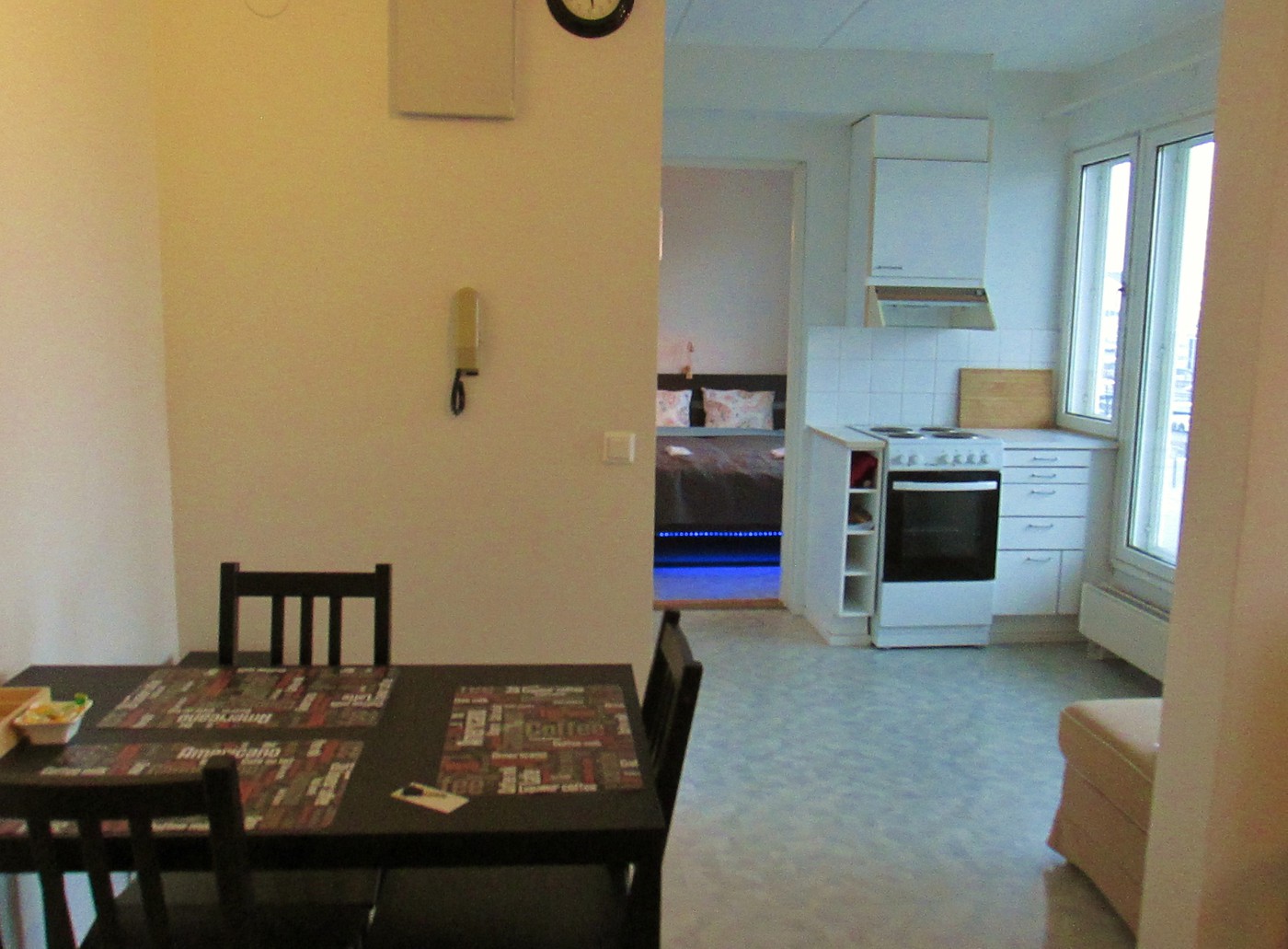 My home in Helsinki
My home in Helsinki
 Only $62.50 per night! With a balcony!
Only $62.50 per night! With a balcony!
As the saying so aptly goes, though - time flies when you’re having fun – and so it was that after locating a suburban laundromat (thank God for Google Maps and Directions!) I emerged with a suitcase full of clean clothes, primed and ready for my upcoming ride on the Trans-Siberian Railway.
March 20, 2017
Aeroflot Helsinki to Moscow 910p – 1145p Airbus A320-200 Economy Class
The extension of light rail out to Helsinki Vantaa International Airport is a wonderful development since my last visit here in 2003. The inexpensive (€5.00) trains depart every 15-20 minutes from the main downtown railway station and take about a half hour to get to the airport.
By the time I arrived at the Aeroflot check-in counter, a sizeable line had developed for economy class passengers. As a longtime top tier elite in my own airline’s program in addition to doing most of my international travel in First or Business Class, I’m not used to standing very long in lines and, as you might imagine, don’t particularly care for to do so. That said, barring SkyTeam elite status my only way out of this line would have been to upgrade to a Business Class ticket at a cost of over $400.00 USD - this for a 540 mile, hour and twenty minute flight. Thankfully, the line moved along at a decent pace and I was through it and checked in within forty minutes.
Before starting out on this trip, I consulted Priority Pass and printed out a listing in order, by airport, of all the lounges and their locations that I’d have access to. In Helsinki, I had a choice of two lounges depending upon which side of the Schengen zone I wanted to be on. I want the lounge closest to my gate and so it was that after clearing immigration and purchasing a single bottle of Jack Daniels at the Duty Free store, I was soon relaxing over a glass of passable white wine, a plate of falafel salad and a bowl of creamy parsnip soup in the Almost Home Lounge. A plaque indicated that this lounge had been awarded European Airport Lounge of the Year by Priority Pass. Hmmm… okay. This wasn’t a very big lounge but it was nicely furnished with a nice selection of foods and beverages available. For my part, I can only offer Lounge of the Trip consideration and thus far I’d have to give that honor to the Premium No. 1 Lounge at London Gatwick, with this lounge and Riga’s rating a very close second.
Down at the gate a fair sized crowd had amassed. I set down my daypack and headed over to the windows to have a look at my Aeroflot jet. This was my first ever flight with Aeroflot, and while an old-timer like me would have preferred to have flown aboard a Soviet era Ilyushin IL-62 or at the very least a speedy Tupolov TU-154, those days have long since been relegated to the dustbin of history. These days, Aeroflot operates a mostly western fleet comprised of Boeing and Airbus equipment. I believe there may still be an IL-96 or two out there, perhaps plying the route between Moscow and say – Havana, Cuba – but for the most part Aeroflot’s long distance fleet is of western manufacture. Tonight’s aircraft was VP-BKY, a nine year old Airbus A320-200. Even through the dark of night, it looked quite handsome in Aeroflot’s attractive “new” silver, blue, red and orange livery.
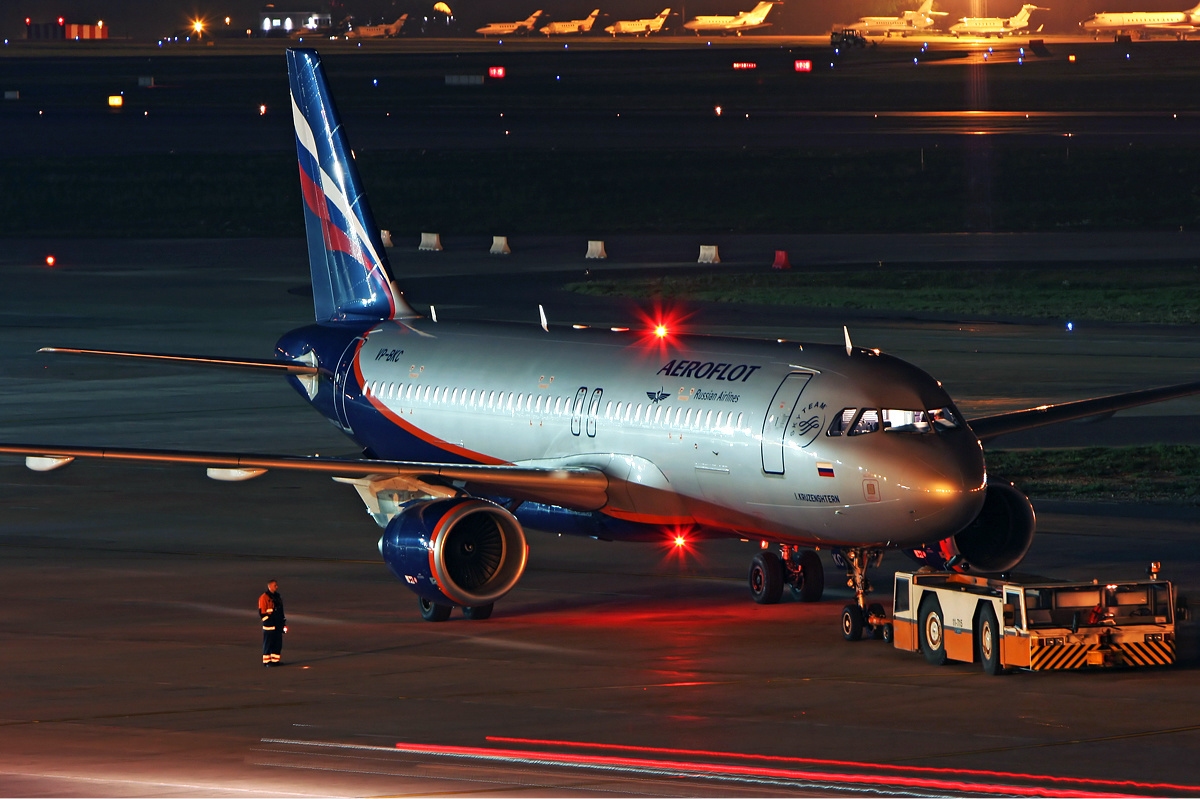 Aeroflot’s Airbus A320-200
Photo courtesy of Wikimedia
Aeroflot’s Airbus A320-200
Photo courtesy of Wikimedia
No boarding announcement was ever made. I looked up from my magazine and lo and behold, boarding was in process. Indeed, it was almost complete! Grabbing my gear, I was quickly scanned by the gate agent and then set off down the jetway. Russia, here I come!
I know Russian women are very pretty but the flight attendant standing at the doorway of the A320 this evening was beyond beautiful - pretty enough to induce lycanthropy in a boy scout! Her face, her eyes and hair… absolutely drop dead gorgeous! Her pretty face remained impassive however as I lumbered past and she didn’t appear to offer much in the way of a smile to me or anyone else at any point during the flight. Hmm…
As I made my way into the aircraft cabin, I was pleased to see that Aeroflot had outfitted its A320 with proper Business Class seating. That meant larger, more spacious seats arranged in a 2-2 configuration. There were 20 blue leather clad recliners with a pitch that looked to be about 40”.
Now in using the term “proper”, some may say that I’m guilty of being nationalistic – seeing and appreciating these seats from only an American perspective – but I fervently believe that given the fares that European airlines are charging their Business Class passengers, they should provide better than lounge access and a slightly better meal. Why Europeans are so accepting of the lousy Business Class seating being offered by most of their airlines is beyond me. I know, I know – the flights are often shorter than those in the U.S. but from what I’ve seen, the pricing certainly isn’t commensurate with the length of the flights relative to what’s charged back in economy.
At check-in I had asked for an aisle seat and surprisingly was assigned an exit-row aisle – the reclining row, no less! Although my back is often sore, I can now handle the weight of an over wing exit door and – though I don’t speak Russian – I can still shout and point pretty well if need be. Still, I was surprised that a non-Russian (or at the very least, Finnish) speaker would be allowed to occupy an exit seat on this flight.
Another thing I noticed – the overhead bins. For an airline with supposed restrictions affecting carry-on luggage, I have never seen the overhead bins stuffed with so much stuff. I was thankful that a spot was arranged for my daypack three rows back. I would have happily put it under the seat in front of me but of course that is not allowed in the exit row.
Back home in the United States – and even on many flights in Europe these days – you would not expect to be fed on a 540 mile, one hour and twenty minute flight, especially one departing at 9:10pm. Not so on Aeroflot where we were presented with an Aeroflot embossed bag containing a decently sized chicken sandwich accompanied by a tangerine and a small fruit bar. I provided the packet of Grey Poupon.
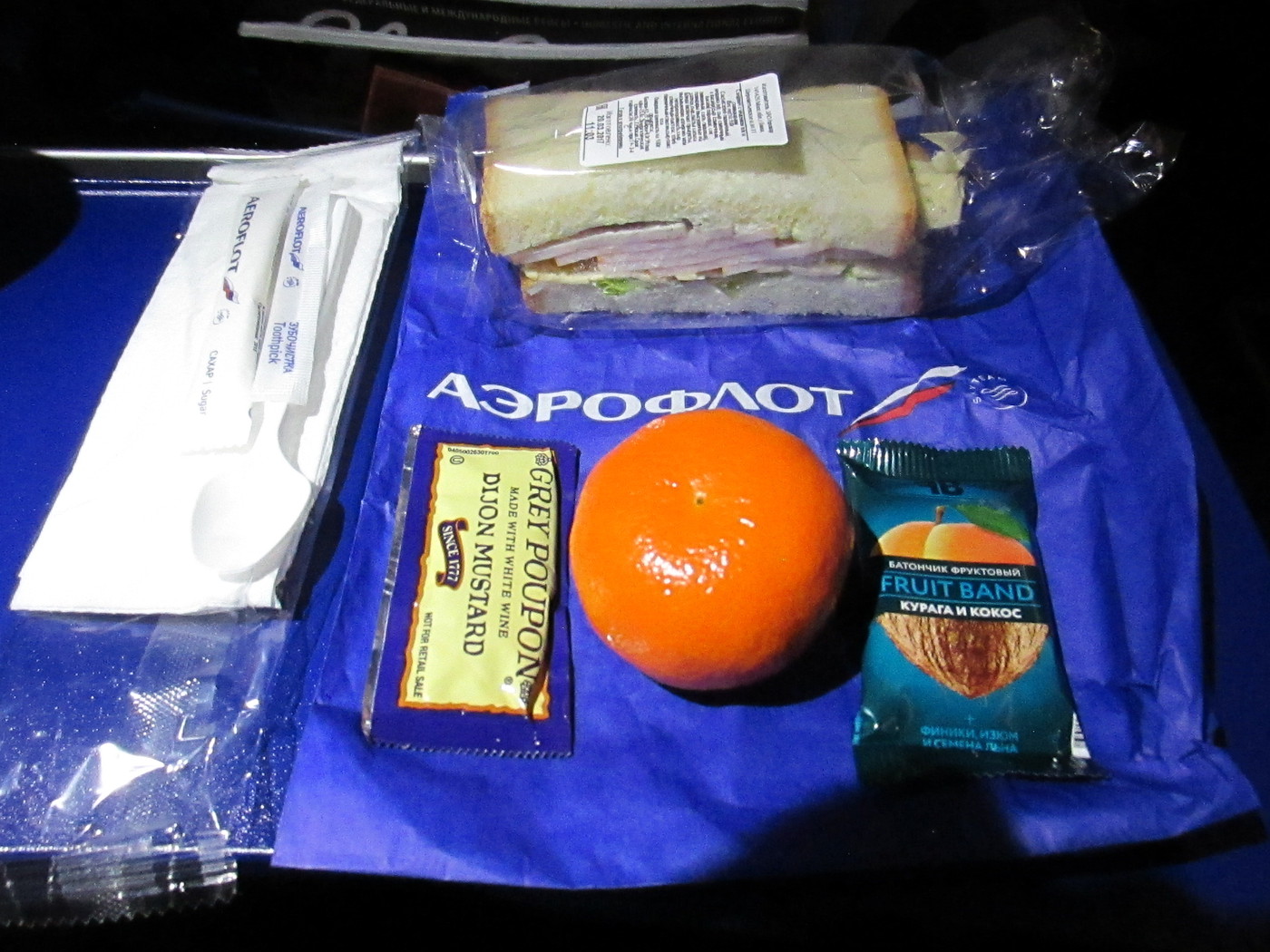 Snack time on Aeroflot
Snack time on Aeroflot
Perhaps even more amazing - I watched through the open divider as the Business Class flight attendant smiled and graciously presented menus to each of her passengers. Menus! On a 540 mile flight! Actually, now that I think of it, I recall getting a menu and a very nice meal while flying aboard Turkish Airlines between Athens and Istanbul – a flight of one hour and 340 miles.
In any event, I was very pleased with the service I received on this flight – even from the beautiful but stern-faced flight attendant noted earlier at the door. Where Aeroflot used to inspire unpleasant visions of lackluster service aboard aging Soviet era equipment, if this flight is any indication it would seem they’ve improved their product significantly.
Nicely done, Aeroflot! I look forward to my next flight – hopefully in Business Class.
* * * :-: * * * :-: * * *
I grew up in America during the Cold War years. Add to that all the stuff we’ve been hearing about Russia lately and I couldn’t help but have a little twinge of anxiety on this - my very first visit to Russia. A number of “What ifs” circulated through my mind.
What if my Visa isn’t in order?
What if they search my bag and find something they deem questionable?
What if they demand to see my train ticket? (It’s waiting for me at the hotel)
What if they just want to give me a hard time - for whatever reason?
Countering those concerns was the fact that Americans – in ever increasing numbers – have been visiting Russia for years, and returning home with generally good experiences to relate. So – while the concerns were perhaps understandable given my inculcation past and present, I generally cast them aside and presented myself to the immigration officer with a neutral expression and no particular expectations aside from being granted entry into the country.
Which I was, although the lady who took my passport was every bit as stern in countenance as the border guards we see depicted in old espionage movies. She gave me the quick once over, scanned my passport, typed some things into her computer, said not a word and never smiled before stamping my passport and waving on the next person in line.
Welcome to Russia.
The real headache came in dealing with the Russian cabbies that congregate outside the arrivals area with all the persistence of mosquitoes on a hot summer day in the Alaska Bush. Having been informed by the Information kiosk that the bus for my hotel – the Park Inn by Radisson – came around every half hour, I then had to run the gauntlet of aggressive cab drivers, fending off a number of them enroute to the hotel bus pick-up point.
My interaction with one of them went like this:
Cabbie: You need taxi?
Me: No thanks. I’m catching a bus to a hotel
Cabbie: What hotel you stay at?
Me: The Radisson
Cabbie: Oh! That bus just leave 5 minutes ago! The next one won’t be for hour.
Me: I was told they run every half hour
Cabbie: Not this late at night. Next bus one hour. I drive you to hotel in few minutes!
Me: No thanks, I’ll just wait.
Cabbie: Serious! In few minutes you be sleeping in room!
Me: That’s alright – I’ll wait.
Cabbie: I give you special rate. You be sleeping in room soon!
Me: How much?
Cabbie: 700 rubles (About $12.00 USD)
Me: That’s okay. I’ll wait.
Cabbie: Sometimes bus is late.
Me: I’m a patient guy. See ya.
I’m sure that “bus just left 5 minutes ago” routine has worked on plenty of Ma & Pa Kettle types at 12:30am. As for me though – well, let’s just say this ain’t my first rodeo.
Truth be known, the cabbie was probably correct in his assertion that the hotel bus had left 5 minutes earlier because I did indeed have to wait until a little after 1:00am (about a half hour) but the bus did indeed show and it cost me nothing to get to the hotel.
I’m guessing that despite its 4-star rating on most travel sites, the Park Inn by Radisson is a lesser brand akin to Fairfield by Marriott. For some odd reason, that line from the movie “Fargo” comes to mind… “It’s a Radisson, you know, so… it’s pretty good.” That said, the lobby was bright and attractive, the receptionists spoke excellent English, check-in went smoothly and best of all, my train tickets had arrived by courier earlier in the day. The receptionist handed them to me with my key card. I was able to arrange a late check out and then headed up to my room – a standard double – located up on the 8th floor.
Upon opening my door I was a bit surprised to see two single beds or what we call “twin beds” back in the states. The only time I’ve ever seen them in a U.S. hotel or even motel was if the room was set up for families or triple occupancy. To see them here in a $94.00/night room at a Radisson was a bit of a surprise. Still, I can sleep just fine in a single bed. Of more immediate concern was that the room was very warm. Thankfully I was able to crack open a window where the sub-freezing night air did a nice job of quickly cooling the room down. I slept well and slept late, took a leisurely morning of puttering about my room and working on this trip report and then headed down to the hotel restaurant for a late lunch.
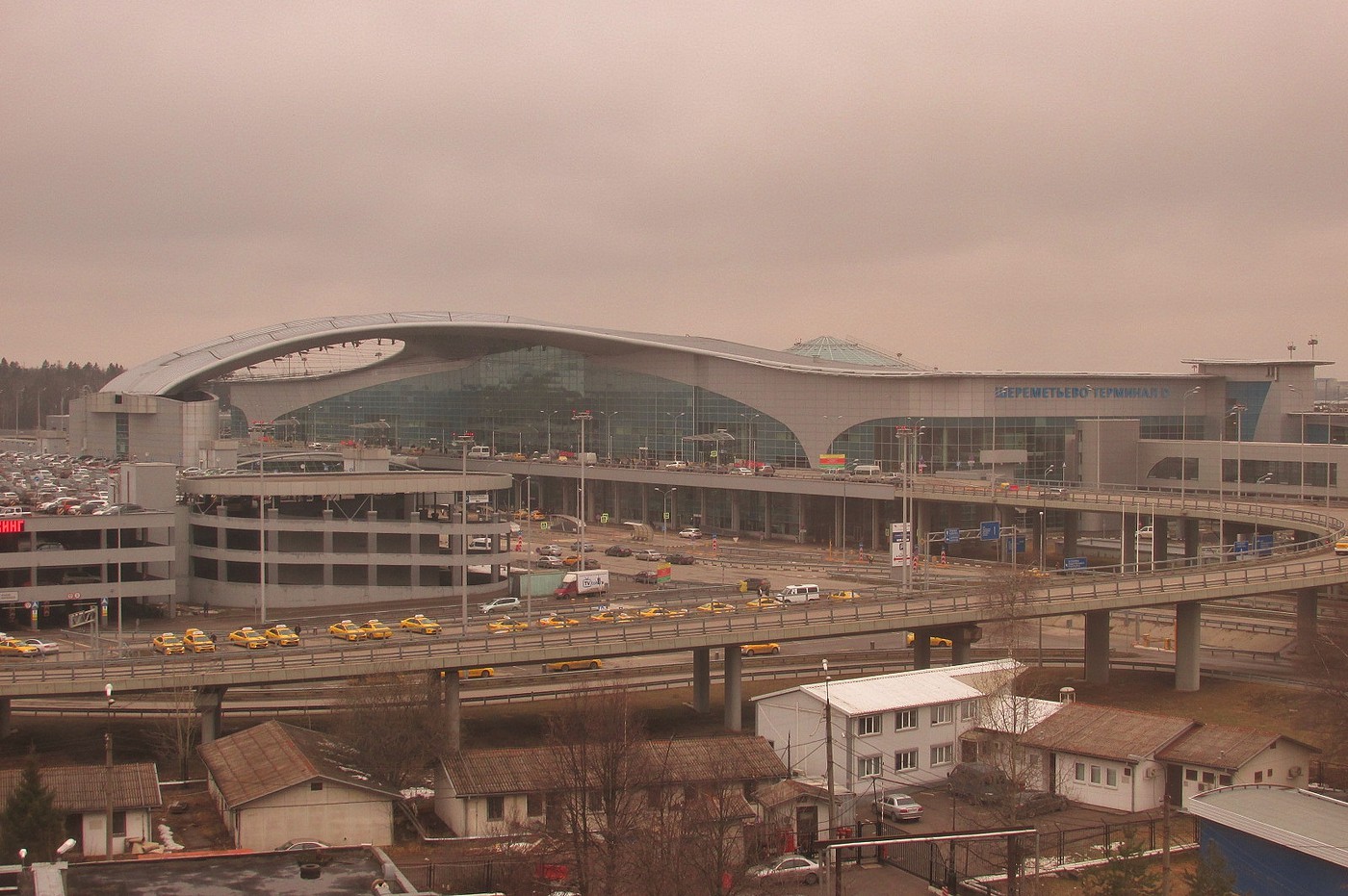 Aeroflot’s Terminal D at Moscow Sheremetyevo Airport
As seen from my hotel room
Aeroflot’s Terminal D at Moscow Sheremetyevo Airport
As seen from my hotel room]
* * * :-: * * * :-: * * *
Prior to departing on this trip I did a bit of research on getting from Sheremetyevo to the Yaroslavsky Railway Station. The city of Moscow is served by five railway stations – three of them all congregated around one square. The least expensive way to get from the airport to Yaroslavsky Station involved catching the AeroExpress train to the Belorusskiy Station. From there you just follow the signs to the metro and take the Circular Line (It’s colored brown on the system wide map) to the Komsomolskaya Metro Station. Total cost was under $10.00 USD. The only tough part is that all of the signage is in Cyrillic so I also printed up the various names I’d need to look out for in Cyrillic and enlarged them. They weren’t hard to identify. Once I got upstairs into the square above the Komsomolskaya Metro Station, there was no mistaking the Yaroslavsky Railway Station. It’s a very distinctive building.
 Moscow’s Yaroslavsky Railway Terminal
Moscow’s Yaroslavsky Railway Terminal
Entering the station, I couldn’t help but let out a big sigh of relief. It’s been quite a journey so far but here I am, on the precipice of commencing one of the world’s great railway journeys. Now all I have to do is watch for my track to come up on the departures board and then sit back, relax and enjoy the ride.
If I may, I’d like to suggest that now might be a good time to refill those drinks and restock those snack plates. We’ve got a long ride ahead of us - 4,735 miles (7621 km) to be exact.
All aboard!